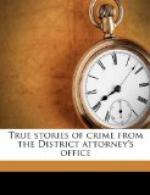About a month after Patrick’s first visit to the Berkshire Apartments, that is, in December, 1899, while he and Jones were examining Rice’s private papers, they stumbled upon the will. Patrick saw his opportunity. By the forgery of a new will which would increase the legacies of those mentioned in the will of 1896 and leave legacies to every person who might have any claim upon the estate, it would be for the interest of those persons to sustain and carry into effect the forgery. The whole scheme was based upon the belief that “every man has his price.” He told Jones that he thought the will unjust; that he did not think it right to leave so little to relatives, and later he brought to Jones a rough draft of a will which could be substituted for the genuine one. Patrick was to get half the estate, the relatives were to receive double or three times the amount provided in the 1896 will, and what was left was to be given to the Rice Institute. He proposed that Jones should typewrite this will, and guaranteed to arrange for the witnessing and signing of it, and promised that Jones should get whatever he wanted. Jones at first objected, but was finally won over. Rewritten many times to include new ideas of the conspirators, the document finally reached the form of the will of June 30, 1900, in which Patrick substituted himself for the Rice Institute and made himself one of the executors.
An ingenious part of the conspiracy was the decision to leave the 1896 will in existence. If Patrick had destroyed it and the relatives had succeeded in overthrowing the will of 1900, the estate would have been left without testamentary disposition and the relatives would have got more than was provided by either will. With the will of 1896 in existence, however, the relatives would get less if they overthrew the forgery. By retaining it, therefore, Patrick figured that the relatives would have selfish reasons for accepting the forgery as genuine.
The preparation of this bogus will occupied about a month, and the next question was the procurement of witnesses. It was desirable to get the same persons who witnessed the former will. These were Walter H. Wetherbee and W. F. Harmon, clerks for many years at Swenson’s banking house. On the assumption that Wetherbee had been injured by Rice and was therefore hostile to him, Jones practically unfolded the scheme. He told Wetherbee that one of Mr. Rice’s bonds had disappeared and that Rice had accused Wetherbee of stealing it. He wound up with the suggestion, “I will get one witness and you can get another, and the thing is done.” But Wetherbee indignantly declined to join in the conspiracy.
Morris Meyers, who had been employed in Patrick’s office, and David L. Short, a friend of both, were the false witnesses finally selected.
They were clothed with the appearance of honesty and were brought into contact with Rice by Jones at various times: Meyers as a notary public, and Short as commissioner of deeds for the State of Texas, an appointment procured for him by Patrick probably for this specific purpose.




